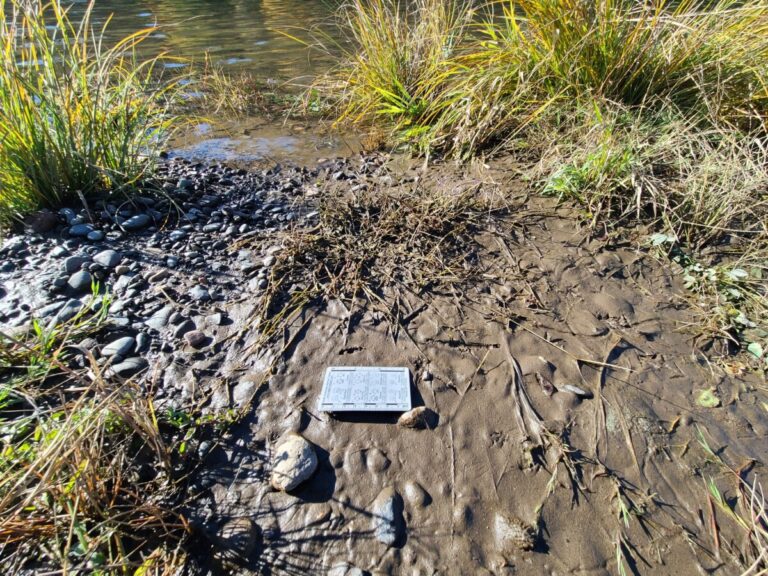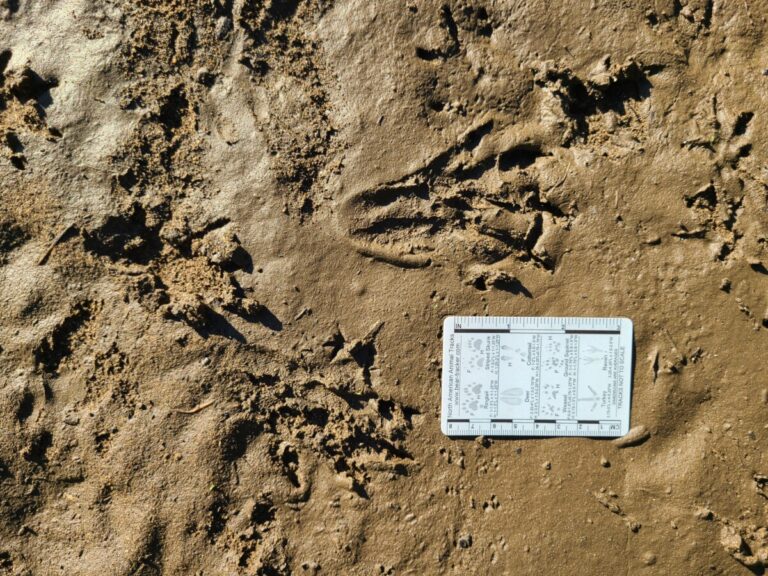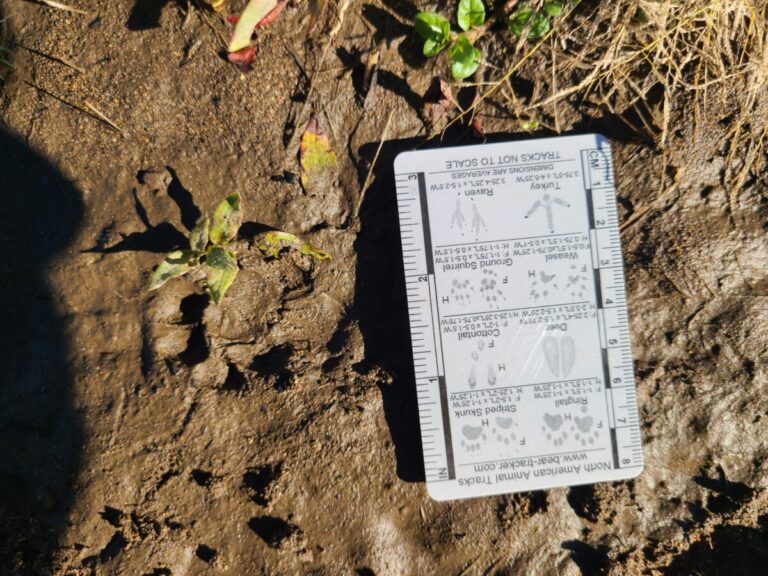Featured Image: Spotted Sandpiper and worm tracks in the mud.
Conditions looked good for a couple days of animal tracking, so I planned an afternoon at River Forks Park then a full day up at Lemolo Lake the next day. It was interesting to see the similarities and differences. Enjoy!
River Forks Park is one of Douglas County’s most beautiful parks, located at the confluence of the North and South Umpqua rivers about 5 miles NW of Roseburg. It features acres of flat and rolling grassy areas dotted with trees. An upper flat area has a nice mix of beautiful Oregon White and California Black oaks, and nearby play areas. Down along the main Umpqua River, at the confluence of the two forks, is a wide cobble, gravel, and sandbar. This is a favored area for swimming or just “getting wet” in the summer months and occasional bank fishing in season. Little do most people know, there are also lots of animal tracks along the river.
When the river swells from rain or melting snow, the sandy and muddy areas of the river bank are wiped clean, erasing previous animal tracks as well as those of the people and dogs that have enjoyed the area. As the water levels lower, the canvas is blank, and local wildlife begin to paint their presence upon the fresh smooth sand and silt.
My efforts to recognize and interpret animal tracks and trails has come in spurts, and recently I’ve gotten the urge to immerse myself in the practice again. River Forks Park is a great local spot just a 15-minute drive from my house. On the afternoon of November 7, 2024, I spent a couple hours there. I simultaneously record an eBird list when I’m tracking or out anywhere. eBird records my track, which I find useful for other purposes such as this (see below).

From the parking lot I walked west along the edge of the oak woods, above a low grassy area that floods when the river gets high. I made my way to the gravel bar which has abundant sand as well as areas of gravel and cobble. Farther north along the edge are areas where water eddies and releases fine sediment during slight raises in water level. Here there is fine silt and mud.
Immediately upon entering the sand, there were of course people and dog tracks, but only a few yards into the sand bar were deer tracks traveling left to right, going down river. Both White-tailed and Black-tailed deer are in the area, so I’m not able to tell which it is based on the track. But these tracks look not too old, probably made in the last 48 hours. As the displaced sand dries out it begins to crumble and fall into the track.

Only a minute later, tracks of the nearly omnipresent omnivore, the Common Raccoon were fairly easy to spot. Raccoon tracks are somewhat similar to human hands in that they often look like they have “fingers”–some say little sausages–connected to the pads of their feet. Nevertheless, slight changes in a raccoon’s gate, or tensing/curling of the fingers/toes can create many variations in their tracks that are often mistaken for otter, fox, bobcat, and other species.



A few minutes later, still in the sandy area, were some relatively subtle tracks. They were not very noticeable among the variety of other disturbances on the sand. But they displayed a neat symmetry, with toes rather tight together, the side toes close behind the front toes, and with obvious nails/claws on all four toes. These are all typical features of Canids (the dog family). Being so small I would call it a fox, but the nails seems rather pronounced and blunt, so it is probably someone’s small-breed dog, or “yipper-snapper” as I call them. A fox would typically show little or no nails because they are typically much finer, more pointy than a domestic dog which has its claws trimmed now and then.



Nearby was a somewhat faint but fairly typical track of a medium-sized domestic dog. The track was dried out and filling in, but the symmetrical shape, small pad, and strong blunt nails were apparent.

More raccoon tracks appeared, but I wanted to get down closer to the water to look for Spotted Sandpiper, Killdeer, and other waterbird and shorebird tracks, so I kept moving. Immediately at the water’s edge, in some fine silt were some beautiful Spotted Sandpiper tracks. Of the smaller shorebirds in our area this time of year, Spotted Sandpiper tracks are most similar to Killdeer tracks, but Killdeer don’t have a hallux, or rear toe (numbered as toe 1). Not all Spotted Sandpiper tracks show the very small rear toe of the sandpiper, but usually several of the tracks show toe 1; sometimes only a small dot behind the rest of the track. See if you can spot it on the tracks below.




Fairly close by was a huge bird track that dwarfed those of the Spotted Sandpiper. This was the track of a Great Blue Heron or Great Egret. I lean towards egret because of the relatively thin toes–both species were seen here this day–but I need more experience distinguishing their tracks, so I’ll just leave it at genus Ardea until I see one make a track.


At this point I exited north of the beach proper and entered a narrower shore with more mud. Few people venture this way, which results in fewer people or dog tracks and more mud and wildlife tracks. Here and there were pathways up through the reed-canary grass and other forbs and weeds going toward the river bank where there are more willows, blackberry, and other shrubs which supply food, building supplies, and cover for many species. Tracks in the fine mud near shore began to become more concentrated and here I saw my first Nutria tracks of the day. Nutria were brought to Oregon for fur farming about 100 years ago and once escaped or released they populated many lowland rivers and ponds. Their tracks are roughly similar to American Beaver and Muskrat (AKA large rodents), but in between in size, with a number of specific differences. Also nearby were Nutria scat, distinctive elongated pellets with striations on the side.






Nearby was a large area of mud over sand that had hundreds of tracks and sign. In the area were tracks, leftover limbs and drag marks from American Beaver hauling branches. In addition there were tracks of Nutria, Muskrat, domestic cat, Common Raccoon, Spotted Sandpiper, some type of duck and a variety of invertebrates. Some of these are shown below.

Following are some closer views of individual species tracks; first some birds, then some mammals.

























After plenty of time deciphering a wide variety of tracks here, I decided to walk upriver and see what I could find on the way back to my pickup. On the way up was a big splattering of white-wash on a cobble field, likely from a Great Blue Heron. Also present were some human prints, or rather shoe prints.



Up the north bank of the North Umpqua River were more raccoon tracks as well as beaver tracks and sign.








Well, not a bad 2.5 hours at River Forks Park. There were not many people down at the beach, just one fishermen for a short time. A couple fishermen in boats came by. I could have continued farther up the North Umpqua River, but I had to go.
Species of tracks or sign observed:
Common Raccoon
American Beaver
Nutria
Muskrat
Domestic cat
Fox (maybe?)
Black-tailed or White-tailed Deer
Great Blue Heron or Great Egret
Spotted Sandpiper
Medium-sized duck species
Passerine species
Earthworm
Domestic dog
Human
As I type, the rains have been coming down for over 12 hours. The river levels have risen just a foot or two so far, but enough to again wipe the slate clean for another day of tracking.
If you have any insights about what I saw, please share in the comments below! Thank-you! Then, join me on the following day’s tracking at Lemolo Lake!

This Post Has One Comment
So very interesting as you unfold the mysteries of nature! Your interests, hard work, and conclusions benefit us all. Nature is truly amazing as it somehow manages to survive and even flourish in spite of our presence.